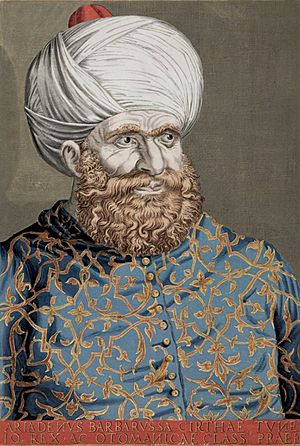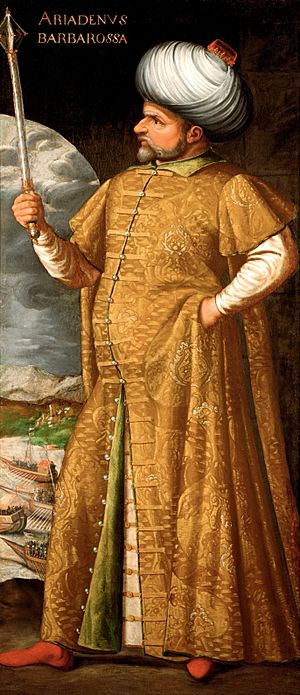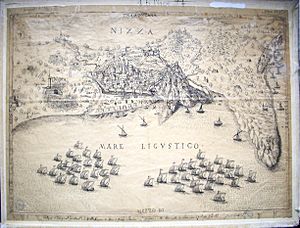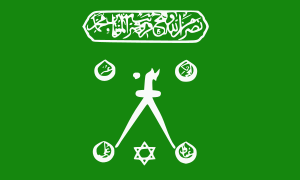Hayreddin Barbarossa facts for kids
Quick facts for kids
Hayreddin Barbarossa
|
|
|---|---|
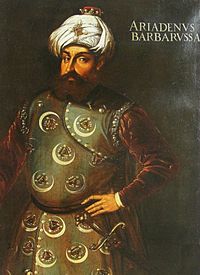
A portrait of Hayreddin Barbarossa
|
|
| Nickname(s) | Barbarossa (Redbeard) Hayreddin Hızır Reis |
| Born | c. 1478 Lesbos, Ottoman Empire |
| Died | 4 July 1546 (aged 67–68) Büyükdere, Ottoman Empire |
| Allegiance | |
| Service/ |
|
| Years of service | c. 1500–1545 |
| Rank | Kapudan Pasha (Admiral) |
| Battles/wars |
|
| Children | Hasan Pasha |
| Relations | Yakup Ağa (father) Katerina (mother) Ishak (brother) Oruç Reis (brother) Ilyas (brother) |
Hayreddin Barbarossa (born Khiḍr, around 1478 – July 4, 1546) was a famous Ottoman admiral. He was also known as Hayreddin Pasha or Hızır Reis. He started his career as a privateer, which was like a government-approved pirate. Later, he became the Grand Admiral of the Ottoman Navy. His amazing victories at sea helped the Ottoman Empire become very powerful in the Mediterranean Sea during the mid-1500s.
Hayreddin was born on the island of Lesbos. He began sailing with his older brother, Oruç Reis. In 1516, the brothers took control of Algiers from Spain. After Oruç died in 1518, Khiḍr took over his brother's nickname, "Barbarossa," which means "Redbeard" in Italian. He also received the special name Hayreddin, meaning "goodness of the faith." In 1529, Barbarossa captured the Peñón of Algiers, a Spanish fort near Algiers.
In 1533, the Ottoman Sultan, Suleiman the Magnificent, made Barbarossa the Grand Admiral of the Ottoman Navy. He led important missions, including a trip to France. He conquered Tunis in 1534 and won a major battle against a European alliance at Preveza in 1538. He even worked with the French navy in the 1540s. Barbarossa retired in 1545 and passed away the next year.
Contents
Who Was Hayreddin Barbarossa?
Hayreddin was born on the island of Lesbos in the Ottoman Empire. His father, Yakup Ağa, was an Ottoman soldier. His mother, Katerina, was a Greek Christian. They had four sons: Ishak, Oruç, Khiḍr (Hayreddin), and Ilyas. Yakup Ağa was given land on Lesbos after the Ottomans conquered the island. He became a potter and used a boat to trade his goods. His sons helped him with the family business.
Early Adventures at Sea
All four brothers became sailors. They were involved in sea trade and later became privateers. Privateers were like legal pirates who attacked ships from enemy countries. They fought against the Knights Hospitaller, a group of Christian knights based on the island of Rhodes. Oruç and Ilyas sailed in the eastern Mediterranean, while Khiḍr sailed in the Aegean Sea. Ishak, the oldest brother, stayed on Lesbos to manage the family's money.
Oruç's Capture and Escape
Oruç was a very skilled sailor. He could speak Italian, Spanish, French, Greek, and Arabic. One day, while returning from a trading trip, he and his younger brother Ilyas were attacked by the Knights of St John. Ilyas was killed, and Oruç was captured. He was held prisoner in Bodrum Castle for almost three years. Khiḍr found out where his brother was and helped him escape.
Oruç Becomes a Famous Privateer
After escaping, Oruç went to Antalya. An Ottoman prince gave him 18 ships to fight the Knights of St John. Later, he received an even larger fleet. He attacked coastal castles in Italy and captured enemy ships. He also helped move thousands of Muslim people from Christian Spain to safer lands in North Africa. Because of this, people started calling him Baba Oruç, meaning "Father Oruç." Over time, this name became "Barbarossa" in Europe, meaning "Redbeard."
Khiḍr Joins His Brothers
Khiḍr joined Oruç in Djerba, an island that became their new base. In 1504, the brothers got permission from the ruler of Tunis to use the port of La Goulette. They agreed to give him one-third of their captured treasures. They became very famous for their raids, capturing many ships and soldiers. Other privateers joined them. In 1509, Ishak also joined his brothers.
In 1512, Oruç lost his left arm in a battle. He then used a silver arm, earning him the nickname Gümüş Kol ("Silver Arm"). The brothers continued their raids, capturing many ships and even building a gunpowder factory. They attacked Spanish and Genoese ships and fortresses.
Rulers of Algiers
In 1516, the three brothers successfully captured Jijel and Algiers from the Spanish. They took control of the city, forcing the previous ruler to flee. The Spanish in Algiers asked their king, Charles V, for help, but his fleet could not defeat the brothers.
Oruç decided that the best way to protect Algiers from Spain was to join the Ottoman Empire. In 1517, he offered Algiers to the Ottoman Sultan, Selim I. The Sultan accepted Algiers as an Ottoman province. He made Oruç the Governor of Algiers and the Chief Sea Governor of the Western Mediterranean. The Sultan also promised to send soldiers and cannons to help.
The Deaths of Oruç and Ishak
The Spanish ordered a new ruler of Tlemcen to attack Oruç. But Oruç attacked Tlemcen first, capturing the city. In May 1518, Emperor Charles V arrived with 10,000 Spanish soldiers and local fighters. Oruç and Ishak defended Tlemcen for 20 days with their soldiers. Sadly, both Oruç and Ishak were killed in the fighting.
Hayreddin Becomes Barbarossa
After his brothers' deaths, Khiḍr felt his position was in danger. He contacted Sultan Selim I and promised his loyalty. In 1519, the Sultan gave him the title of Beylerbey (Chief Governor) and sent him more soldiers and ships. Khiḍr inherited his brother's position, his famous nickname "Barbarossa," and his mission to control the seas.
Hayreddin's Later Career
With new Ottoman soldiers, Barbarossa recaptured Tlemcen in December 1518. He continued to help move Muslims from Spain to North Africa. This made many people loyal to him. He captured other cities like Annaba and defeated a Spanish-Italian army that tried to take back Algiers. He also raided coasts in France and the Balearic Islands.
In 1522, Barbarossa sent his ships to help the Ottoman Empire conquer Rhodes. This led to the Knights of St John leaving the island. Over the next few years, he raided many ports and castles along the coasts of Italy and Spain. In 1529, he captured the Spanish fort on the Peñón of Algiers. He also helped transport 70,000 Muslims from Spain to Algiers.
In 1530, he continued his raids in Sicily, the Balearic Islands, and France. He captured many ships and even a castle in the Balearic Islands, using it as a base. In 1531, he fought against a large Spanish-Genoese fleet and won. He also attacked Tripoli, which had been given to the Knights of St John.
In 1532, Sultan Suleiman I realized he needed a strong commander at sea. He called Barbarossa to Istanbul. Barbarossa sailed there, raiding islands and capturing ships along the way. He arrived in Istanbul with 19 ships and was welcomed by the Sultan. Suleiman made Barbarossa the Kapudan-i Derya (Grand Admiral) of the Ottoman Navy and the Chief Governor of North Africa.
Working with France
In 1533, Barbarossa sent a special message to the King of France, Francis I. France and the Ottoman Empire became allies against their common enemy, the Habsburg Empire.
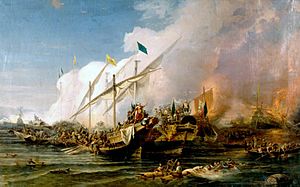
In 1534, Barbarossa sailed from Istanbul with 80 ships. He recaptured several cities from the Spanish. He then raided the coasts of Italy, capturing many ships and towns. He even threatened Rome, causing alarm in the city. In August 1534, he captured Tunis and its important port, La Goulette.
The ruler of Tunis, Mulay Hassan, asked Emperor Charles V for help. A large Spanish-Italian force recaptured Tunis in 1535. Barbarossa had already left Tunis, sailing to the Tyrrhenian Sea. He continued to raid ports, including Capri, where he rebuilt a fort that still bears his name. He then returned to Algiers and attacked Spanish coastal towns.
In 1536, Barbarossa was called back to Istanbul to lead a naval attack on the Kingdom of Naples. In 1537, he captured cities in Italy like Otranto and Castro. He also led a large Ottoman force that captured many islands in the Aegean and Ionian Seas from the Republic of Venice. He attacked Corfu, but its strong fortress held out. These losses made Venice ask Pope Paul III to create a "Holy League" against the Ottomans.
In February 1538, the Pope formed the Holy League, which included Spain, the Holy Roman Empire, Venice, and the Maltese Knights. But Barbarossa's forces defeated their combined fleet at the Battle of Preveza in September 1538. This victory made the Ottoman Empire the most powerful force in the Mediterranean for the next 33 years.
In 1539, Barbarossa captured more islands and recaptured Castelnuovo from the Spanish. Venice finally signed a peace treaty with Sultan Suleiman in 1540, agreeing to pay a large sum of gold.
In 1540, Barbarossa attacked and captured the town of Gibraltar, taking many prisoners. In 1541, Emperor Charles V tried to convince Barbarossa to switch sides and become his admiral, but Barbarossa refused. Charles then tried to attack Algiers, but a violent storm destroyed much of his fleet, forcing him to retreat.
In 1543, Barbarossa sailed to Marseilles to help France, an ally of the Ottoman Empire. He had a huge fleet of 210 ships and 14,000 soldiers. On his way, he captured Reggio Calabria in Italy. He then threatened Rome, but France helped protect the city. Barbarossa raided several Italian and Spanish islands. He then helped the French besiege and capture the city of Nice on August 5, 1543.
The French King, Francis I, even allowed Barbarossa to use the city of Toulon as a base for six months. Toulon became like a Turkish city, with its own mosque and slave market.
In 1544, Barbarossa defeated another Spanish-Italian fleet. He then sailed to Genoa and threatened to attack the city unless they released Turgut Reis, another famous Ottoman admiral who was imprisoned there. Barbarossa successfully got Turgut Reis released. He continued to fight against Spanish attacks in southern France.
After leaving France in May 1544, Barbarossa continued his raids. He captured towns in Tuscany and destroyed the tomb of a man who had burned his father's house. He also captured islands like Ischia and Procida. He finally returned to Istanbul. In 1545, he went on his last naval expeditions, attacking Spanish ports and islands before returning to Istanbul for good. He built a palace on the Bosphorus strait.
Retirement and Legacy
Hayreddin Barbarossa retired in Istanbul in 1545. His son, Hasan Pasha, took over his role in Algiers. Barbarossa dictated his life story, which is known as Conquests of Hayreddin Pasha. These books are now in the Topkapı Palace and Istanbul University Library.
Barbarossa Hayreddin Pasha passed away in 1546 at his palace in Istanbul. He is buried in a tall tomb built by the famous architect Mimar Sinan. His tomb is near the ferry port in the Beşiktaş district of Istanbul, where his fleet used to gather. A memorial was built next to his tomb in 1944.
Barbarossa's Flag
Barbarossa's flag was very special. At the top, it had Arabic writing that means, "Victory from Allah and an eminent conquest; and give good tidings to the believers, O Muhammad."
Inside the four crescent moons were the names of the first four leaders of Islam after Muhammad: Abu Bakr, Umar, Uthman, and Ali. The two-bladed sword on the flag represents Dhu'l-Fiqar, a famous sword in Islamic history.
The six-pointed star on the flag might look like the Star of David, but in medieval times, this star was a common Islamic symbol called the Seal of Solomon. It was used by many Turkish rulers and on Ottoman decorations.
Barbarossa's Impact
Hayreddin Barbarossa made the Ottoman Empire very strong in the Mediterranean Sea. This power lasted until the Battle of Lepanto in 1571. Even after that defeat, the Ottomans quickly rebuilt their navy and gained more land.
Many Ottoman admirals were great, but few achieved the same level of power as Hayreddin Barbarossa.
His tomb and a statue of him are in Barbaros Park in Istanbul, next to the Istanbul Naval Museum. There are verses by a Turkish poet on the back of his statue. The main road in Istanbul, Barbaros Boulevard, is named after him.
For centuries after his death, Ottoman ships would fire a salute at his tomb when passing by. This tradition was brought back by the Turkish navy in 2019. Several warships and passenger ships of the Turkish Navy have been named after him.
Outside of Turkey, the historian Edward Keble Chatterton called him "the greatest pirate that has ever lived" and a very clever military leader. He noted that Christian Europe was very relieved when he died.
Barbarossa in Pop Culture
Hayreddin Barbarossa has been featured in many Turkish films and TV shows. The fictional character Hector Barbossa in the Pirates of the Caribbean movies is named after him.
In the 2021 Turkish TV series Barbaros: Sword of the Mediterranean, Hayreddin Barbarossa is played by actor Ulas Tuna Astepe. In the 2022 Turkish TV series Barbaros Hayreddin: Sultan's Edict, he is played by actor Tolgahan Sayışman.
Images for kids
-
Bodrum Castle where Oruç was held captive.
-
Barbarossa's Castle on Capri.
-
A map from the Catalan Atlas (1375), showing flags of the time.
See also
 In Spanish: Jeireddín Barbarroja para niños
In Spanish: Jeireddín Barbarroja para niños


